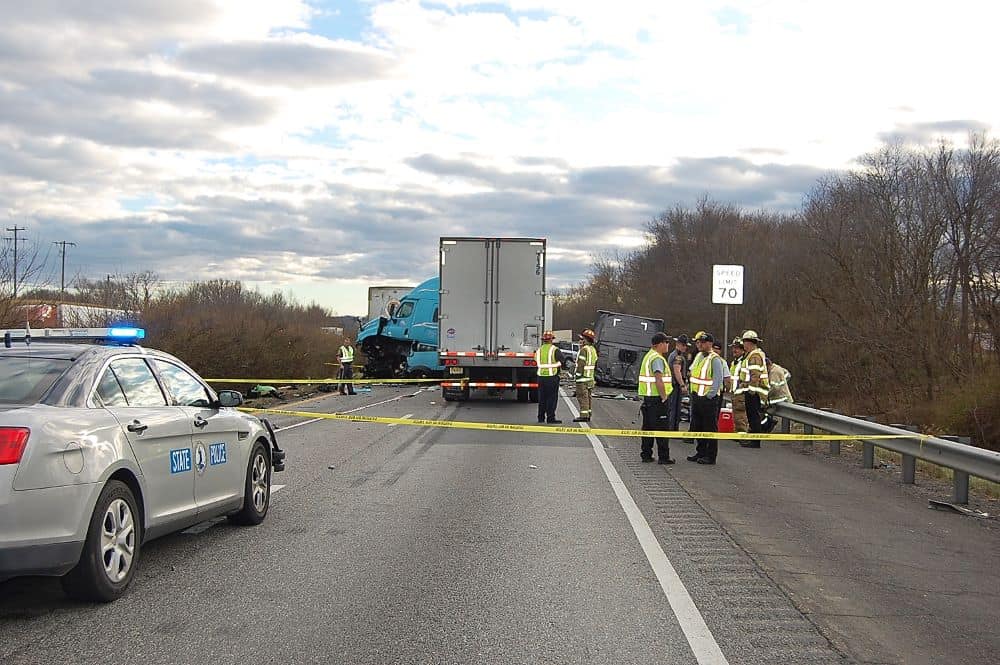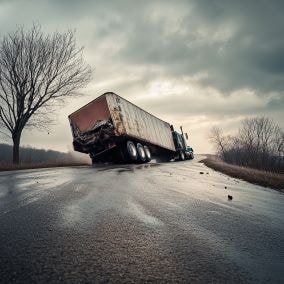Big Truck Accident Crashes
The trucking industry serves as an important part of the growing U.S. economy. It is also a necessary part of many businesses’ supply systems. In fact, more than 70% of all freight in the U.S. is transported by trucks. However, there have been growing concerns about the number of crashes involving big trucks. In recent years, the number of big truck crashes has increased. Understanding the complexities of a truck accident case, including federal regulations and liability issues, is crucial for those affected by these incidents.
Large trucks are defined by the Insurance Institute for Highway Safety as tractor trailers, single-unit trucks, or cargo vans having a gross vehicle weight rating greater than 10,000 pounds. Statistics from recent studies show that there are large numbers of passenger vehicles involved in large truck cases each year.
Recent statistics show that large trucks are involved in a higher rate of crashes than passenger vehicles in the United States. In 2022, a total of 4,764 people died in large truck crashes. Sixty-six percent of these deaths were occupants of passenger vehicles. Analyzing commercial truck accident statistics and trends highlights the safety concerns and consequences posed by these incidents.
Currently, the trucking industry is experiencing a shortage of truck drivers. In January 2024, the trucking industry reported a shortage of 60,000 drivers, which is the highest ever. That figure is projected to triple in the next 10 years. As there are fewer and fewer truck drivers, we can expect there to be more big truck crashes.
Truck Accident Statistics
Truck accidents remain a pressing concern on our nation’s highways. According to the National Highway Traffic Safety Administration (NHTSA), there were over 4,000 fatalities in crashes involving large trucks in 2022. This alarming figure underscores the severity of these incidents and the need for continued vigilance and safety measures.
The Federal Motor Carrier Safety Administration (FMCSA) reports that there were over 400,000 crashes involving large trucks in 2022, resulting in more than 100,000 injuries. These statistics highlight the widespread impact of truck accidents on road safety and public health.
In 2022 alone, there were 4,136 fatalities in crashes involving large trucks. A staggering 73% of these fatalities were occupants of other vehicles, illustrating the disproportionate risk that truck accidents pose to passenger vehicle occupants. In 2022, the number of fatalities from large truck crashes was 51% higher than in 2009.
The most common causes of large truck crashes were driver error, accounting for 63% of incidents. Vehicle maintenance issues contributed to 15% of crashes, while external factors such as weather and road conditions were responsible for 12%. These statistics emphasize the multifaceted nature of truck accidents and the importance of addressing each contributing factor to improve road safety.
Numbers of Large Truck Crashes on the Rise
After a long decline in the number of truck accidents on the roadways, the numbers are once again on the rise. Analyzing the statistics and circumstances surrounding fatal crashes involving large trucks, fatal truck crashes peaked in 1979 at 7,000 and in 2009, those figures bottomed out at 3,600.
Causes of Truck Accidents
Truck accidents can stem from a multitude of factors, each contributing to the complexity and danger of these incidents. One of the primary causes is driver fatigue. Truck drivers often endure long hours on the road, which can lead to exhaustion, and impair their ability to operate their vehicles safely. This fatigue can result in slower reaction times and poor decision-making, increasing the likelihood of an accident.
Distracted driving is another significant factor. With the advent of smartphones and GPS devices, truck drivers may find their attention diverted from the road. Even a momentary lapse in focus can have catastrophic consequences, especially when operating such large and heavy vehicles.
Speeding is also a common issue among truck drivers. In an effort to meet tight deadlines or make up for lost time, some drivers may exceed speed limits, which can drastically increase the risk of a crash. The sheer size and weight of commercial trucks mean that speeding can lead to more severe accidents and injuries.
Vehicle maintenance issues cannot be overlooked as another cause for large truck accidents. Poorly maintained trucks, particularly those with faulty brakes or worn tires, pose a significant risk on the road. Regular inspections and maintenance are crucial to ensure that these vehicles are safe to operate.
Lastly, external factors such as weather conditions play a critical role. Inclement weather, including rain, snow, and fog, can make it challenging for truck drivers to maintain control of their vehicles. Reduced visibility and slippery roads can lead to accidents, emphasizing the need for caution and preparedness in adverse weather conditions.
Types of Large Truck Crashes
Large truck crashes can be categorized into several types, each with its unique characteristics and causes. Understanding these types of crashes is crucial for developing effective safety measures and preventing future accidents.
- Rear-end collisions: These occur when a large truck crashes into the rear of another vehicle. Often, these accidents are the result of driver distraction, fatigue, or inadequate braking. The sheer size and weight of commercial trucks mean that rear-end collisions can cause significant damage and severe injuries to the occupants of the smaller vehicle.
- Head-on collisions: Among the most severe types of large truck crashes, head-on collisions often result in fatalities. These accidents can occur when a truck crosses the center line or enters oncoming traffic, sometimes due to driver error, fatigue, or adverse weather conditions. The impact force in head-on collisions is typically devastating, leading to catastrophic injuries.
- Side-swipe collisions: These occur when a large truck collides with another vehicle traveling in the same direction. Side-swipe collisions often happen due to driver error, such as failing to check blind spots or losing control of the vehicle. The consequences can range from minor scrapes to serious accidents, depending on the speed and angle of impact.
- Jackknife accidents: These occur when a tractor-trailer’s trailer swings out to the side, forming a sharp angle with the cab. Jackknife accidents are often caused by sudden braking, slippery road conditions, or loss of control. These accidents can block multiple lanes of traffic and lead to secondary collisions.
- Rollover accidents: These occur when a large truck tips over onto its side or roof. Rollovers can be caused by excessive speed, sharp turns, driver error, or inadequate cargo securing. The high center of gravity in large trucks makes them particularly susceptible to rollovers, which can result in severe injuries and extensive property damage.
- Underride accidents: These occur when a smaller vehicle collides with the side or rear of a large truck and becomes lodged underneath. Underride accidents often result in severe injuries or fatalities due to the smaller vehicle’s occupants being crushed. These accidents highlight the importance of underride guards and other safety measures to protect smaller vehicles.
Injuries and Damages
Large truck crashes can result in severe injuries and significant damages, impacting the lives of those involved in profound ways. Here are some of the most common injuries and damages resulting from these accidents:
- Traumatic brain injuries: The force of impact or debris from a crash can cause traumatic brain injuries (TBIs). These injuries can range from mild concussions to severe brain damage, leading to long-term cognitive and physical impairments.
- Spinal cord injuries: Spinal cord injuries can result in paralysis, numbness, or loss of sensation. These injuries often occur due to the violent forces involved in truck crashes, which can damage the spinal cord and surrounding structures.
- Broken bones: The immense force of a truck crash can lead to broken bones, including fractures in the arms, legs, ribs, and pelvis. These injuries can be extremely painful and may require extensive medical treatment and rehabilitation.
- Internal injuries: Internal injuries, such as organ damage, internal bleeding, or punctured lungs, are common in severe truck crashes. These injuries can be life-threatening and often require immediate medical intervention.
- Burn injuries: Fires or explosions resulting from a truck crash can cause burn injuries. These injuries can range from minor burns to severe, life-threatening burns that require specialized medical care and long-term treatment.
- Emotional trauma: Survivors of large truck crashes may experience emotional trauma, including anxiety, depression, or post-traumatic stress disorder (PTSD). The psychological impact of a severe crash can be long-lasting and may require professional mental health support.
When Crashes Cause the Most Injuries
Studies show that in a large truck crash, there is a greater likelihood of lower injury severity if the crash occurs near a curved section of the road or on a roadway sag. Further, the number of horizontal curves and the number of interchanges per mile in the roadway also reduces the likelihood of injury crashes. However, the study also found that head-on collisions and crashes at intersections were the most serious, but crashes on highways were less severe. Additionally, fatalities among truck occupants are a significant concern, with data showing a high percentage of deaths involving truck occupants due to the size and weight discrepancies between large trucks and smaller vehicles.
Distracted driving, driving under the influence, or emotional distraction also tends to increase the likelihood of severe crashes while the fatigue of the truck driver and aggression don’t usually play a large role in the severity of a crash.
When a rear-end collision occurs between a tractor trailer and a car, factors such as darkness, high speed, being struck from the rear, and alcohol increase the chances of severe injuries. In fact, dark conditions while driving are significant factors for increasing injury severity outcomes. Also, driving in the summer months increases the occurrence of severe injury crashes. However, driving in winter weather, on congested roadways, using child restraints, or being in a station wagon type vehicle help to less the severity of any injuries. Lastly, increasing pavement friction decreases the likelihood of injury while snowfall increases the likelihood of more severe injuries.
Surprisingly, in a crash between a large truck and a passenger vehicle, males typically experienced less severe injuries than females. Also, people between the ages of 55 and 65 were also more likely to be severely injured.
Also, the proper use of vehicle restraints is proven to save lives in a large truck versus passenger vehicle crash. Passenger vehicle occupants who are restrained by lap/shoulder belts were less likely to be injured. Vehicle restraints also helps prevent ejection from the vehicle and helps lessen the severity of the injuries.
As the number of vehicles in a collision increases, the level of severity of injuries usually decreases. Often, the reason for this is that cars involved in multiple vehicle crashes have preventive technologies in place which aid in lessening injury severity.
Federal Regulations and Safety Standards
The Federal Motor Carrier Safety Administration (FMCSA) plays a pivotal role in regulating the trucking industry, ensuring that commercial truck drivers and companies adhere to stringent safety standards. One of the key regulations is the Hours of Service (HOS) rules, which dictate how many hours a truck driver can work within a given period. These regulations are designed to prevent driver fatigue, a major cause of truck accidents. These regulations are critical in determining liability and compensation in a truck accident case.
Vehicle maintenance regulations are equally important. The FMCSA requires trucking companies to conduct regular inspections and maintenance of their vehicles to ensure they are safe to operate. This includes checking critical components such as brakes, tires, and lights, which are essential for the safe operation of large trucks.
Driver qualification standards are another crucial aspect of FMCSA regulations. Truck drivers must meet specific qualifications, including obtaining a commercial driver’s license (CDL) and passing a physical exam. These standards ensure that only qualified and physically capable individuals are entrusted with the responsibility of operating commercial trucks.
Investigation and Evidence
Investigating a large truck crash requires a thorough examination of the scene, vehicles, and witnesses. Key evidence in these cases can include:
- Police reports: Police reports provide valuable information about the crash, including the location, time, and parties involved. These reports often contain initial assessments of fault and can be crucial in building a case.
- Witness statements: Witness statements can help reconstruct the events leading up to the crash. Eyewitnesses can provide important details that may not be immediately apparent from the physical evidence alone.
- Vehicle inspection reports: Vehicle inspection reports can reveal potential mechanical issues or maintenance problems that may have contributed to the crash. Regular maintenance records and inspection reports are essential for identifying any negligence on the part of the trucking company.
- Driver logs: Driver logs can indicate whether the driver was fatigued or in violation of hours-of-service regulations. These logs are critical for determining if driver fatigue played a role in the accident.
- Black box data: The black box, or electronic logging device (ELD), in a truck can provide information about the truck’s speed, braking, and acceleration before the crash. This data is invaluable for understanding the truck’s movements and actions leading up to the accident.
- Photographic and video evidence: Photographic and video evidence can help document the scene and damage to the vehicles. This visual evidence can be used to support witness statements and other findings in the investigation.
By understanding the types of large truck crashes, injuries, and damages, as well as the importance of investigation and evidence, truck accident attorneys can better serve their clients and advocate for their rights.

Talk to a Lawyer First!
If you’ve been injured in an accident with a large truck or tractor trailer, you might be contacted by the trucking company’s insurance representative very quickly. Sometimes, insurance companies will try to call you as soon as the day after the accident. Before you talk to any insurance company, you should get the advice of an experienced truck accident lawyer. Most lawyers will give you a free consultation to talk about what you might be entitled to receive. At the Ritchie Law Firm, you can talk to an experienced truck accident lawyer for free . . . NO STRINGS ATTACHED!!
Whether the insurance company contacts you quickly or not, the faster you seek legal advice from a lawyer who knows truck accidents, the better. With a tractor trailer crash, prompt investigation is critical to successfully recovering money damages in your case. Because accidents involving tractor trailers are devastating, making sure that things like skid mark measurements and impact marks are preserved are often essential to a good recovery. See our article on causes of truck accidents here.
Experienced Tractor Trailer Accident Lawyers
The five lawyers at the Ritchie Law Firm have more 145 years of combined experienced handling truck accident cases. See our tractor trailer accident Case Results here. Truck accident attorneys at our firm emphasize their expertise in securing financial compensation for victims of truck accidents. Throughout the nearly half century history of the Ritchie Law Firm, our lawyers have handled thousands of devastating crash cases involving serious and complex injuries such as spinal cord injuries, traumatic brain injuries, internal organ damage, multiple bone fractures, and even death.
You should not have to bear the financial burden of medical bills resulting from a wreck that was caused by a negligent truck driver. Accidents involving tractor trailers are devastating. At the Ritchie Law Firm, we can help you hold the other driver accountable and help you get the compensation you need to pay your bills and recover.
Talk with a Virginia and West Virginia Accident Lawyer
If you or a loved one suffered significant injuries in a trucking accident or tractor trailer accident in Virginia, Ritchie Law Firm is here to help. The experienced, certified attorneys at the Ritchie Law Firm has help. Contact us by phone at 540-388-0542 or by using our online contact form.
Don’t Get Hurt Twice!
You can talk to us for FREE – free consultation
Call today 540-388-0536, fill out the form below or
download our free e-book here
540-388-0536
Ritchie Law Firm is a personal injury law firm devoted to helping individuals who have suffered serious and catastrophic injuries or lost a loved one as a result of someone else’s negligence. Ritchie Law Firm serves all of Virginia, while helping clients in cities and surrounding areas of Harrisonburg, Charlottesville, Staunton, and Winchester also serves clients in West Virginia, including Martinsburg, WV.







